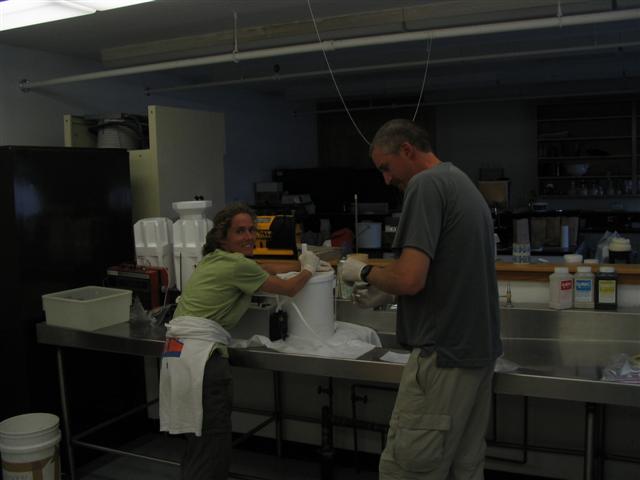( Log In ) Log In is for TREC Teachers & Researchers only
  |
| Amy_Clapp |
 Jul 2 2005, 12:42 AM Jul 2 2005, 12:42 AM
Post
#1
|
 TREC Teacher    Group: TREC Team Posts: 84 Joined: 27-April 05 Member No.: 6 |
So, getting the water samples on the river is only one part of this project. On the river we bottle up some of the water, but the majority of it goes into a churn, which is used to process water once the water gets back to a lab. So yesterday, once we got back to Inuvik, we got some dinner and then set up our lab at the Aurora Research Center. The lab was conveniently located across the street from our hotel.
 It has been fun for me, as I have spent more time in labs (visiting Max at Woods Hole and working with him at various places) to look at the scientific posters that are usually on the walls at research facilities. Having not had a huge science background, it is really fun for me to wander around and read all about all the different science projects going on. The one that was the most interesting to me last night, was research completed by interviewing the elders of Tsiigehtchic about changes they have seen in climate. Noel Andre, the same man that we saw fishing when we were getting ready to sample, was interviewed and talked about how he can’t leave his fish out in the sun to dry as long as he used to because they end up burning. Here we are collecting all these samples on the river, and the elders of the village have many anecdotes to show that climate change is very real here in the Arctic, and also how the climate changes can really affect the lifestyle of the people of the Arctic. So the processing of the samples went very smoothly. Usually it is done by two people, so I came in very handy as the churner. My job was to keep churning the water as it was being pumped out so that the sediments that were in the water would stay suspended instead of settling at the bottom. I have to say that the push-ups I have been doing at night for the last three years didn’t help out….my arm got really sore, quickly!!!  I helped with some of the same processing of the water on the Lena River last year, which we did in our makeshift lab on the boat, since there wasn’t any other lab for us to go to in the village of Zhigansk. I saw a huge difference in the processing, because most of the time during the processing the water is being pumped out of a churn and through different filters before it goes into a bottle. This was not a problem on the Lena River in Siberia because there wasn’t nearly the same amount of sediment. Due to the increased sediment in the churn water from the Mackenzie, the filters were getting clogged really quickly and causing the tubing to pop off. There was really nothing that we could do about it and Bart said that it was pretty normal for that to happen—so we just filtered through as much as we could and recorded all the data about what was happening. The Mackenzie River water looks really muddy compared to the Lena River. Max filled me in on some of the data about the sediments in the water—The Mackenzie River moves 125 million tons of sediment to the ocean each year and the Lena River moves 15 million tons of sediment to the Arctic Ocean AND the Lena River is twice as big as the Mackenzie River. The best explanation for that is that the banks and watershed of the Mackenzie River can erode much easier than the banks of the Lena River.  |
  |
1 User(s) are reading this topic (1 Guests and 0 Anonymous Users)
0 Members:

|
NSF Acknowledgment & Disclaimer | Time is now: 12th November 2024 - 06:50 AM |
Invision Power Board
v2.1.7 © 2024 IPS, Inc.








